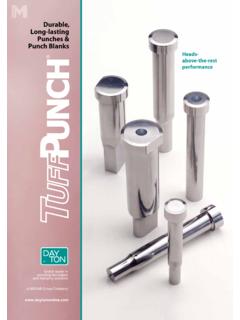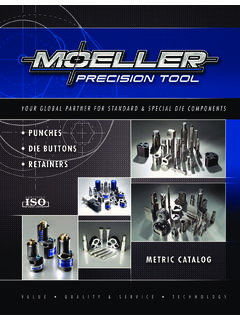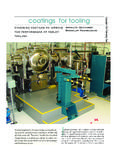Transcription of Perfection - Punch Press Metal Stampings - What …
1 Perfection Spring and stamping Corp. Defining What We Do & Glossary of Terms Progressive Stampings Progressive stamping is a metalworking method that can encompass punching, coining, bending and several other ways of modifying Metal raw material, combined with an automatic feeding system. The feeding system pushes a strip of Metal (as it unrolls from a coil) through all of the stations of a progressive stamping die. Each station performs one or more operations until a finished part is made. The final station is a cutoff operation, which separates the finished part from the carrying web. The carrying web, along with Metal that is punched away in previous operations, is treated as scrap Metal . The progressive stamping die is placed into a reciprocating stamping Press . As the Press moves up, the top die moves with it, which allows the material to feed. When the Press moves down, the die closes and performs the stamping operation.
2 With each stroke of the Press , a completed part is removed from the die. Since additional work is done in each "station" of the die, it is important that the strip be advanced very precisely so that it aligns within a few thousandths of an inch as it moves from station to station. Bullet shaped or conical "pilots" enter previously pierced round holes in the strip to assure this alignment since the feeding mechanism usually cannot provide the necessary precision in feed length. The dies are usually made of tool steel to withstand the high shock loading involved, retain the necessary sharp cutting edge, and resist the abrasive forces involved. The cost is determined by the amount of features, which determine what tooling will need to be used. It is advised to keep the features as simple as possible to keep the cost of tooling to a minimum. Features that are close together produce a problem because it may not provide enough clearance for the Punch , which could result in another station.
3 It can also be problematic to have narrow cuts and protrusions. Punch Press Progressive stamping Glossary of Terms Advance - The amount that a strip or part moves forward in a progressive stamping operation. Also called Jump. Blank Die - A type of cutting tool in which the die matrix is mounted in the lower with a single Punch in the upper. Generally, a blank die has no internal features and the part in passed down through the lower die. Carrier Strip - Sacrificial stock used in a progressive stamping operation that carries the part from station to station. The carrier is linked to the part and eventually becomes scrap once it is cut-free. Compound Die - A type of cutting tool in which the die matrix is mounted in the upper. I compound die has a lower mounted contour Punch and upper mounted perforators and punches for internal features. This is an inverted form of a Blank Die with additional internal holes.
4 Die Land - The amount of straight in a die matrix that exists for sharpening before the relief taper begins. Typically this is about 1/8 to 1 /4 . Die Life - Die Land expressed as grind life or re-sharpening life . Die 1. A matrix within which a Punch creates an opening in a part. 2. A block against which work is done. Die Penetration - The amount that a Punch penetrates a die during a stamping operation. Typically this is about .050 . Die Straight - See Die Land. Refers to the Straight portion of a die profile. French Stop - See Fringe Stop. A misnomer for Fringe Stop. Fringe Stop - In progressive stamping , a stop that is at the fringes of the carrier strip. This stop is a fixed point that will stop the forward progress of a strip once the strip has been notched away. The notch length is typically one stock advance. Sometimes called a French Stop.
5 Heel Block - A tooling component used for heeling. Heel - A Metal -to- Metal condition between two blocks in a tool used to control or balance imbalanced forces. Heel Radius - A radius provided on a tooling component(s) that prevents two blocks from shearing against each other when they are used to contain forces. Heel - To contain forces via a heel block or similar Metal -to- Metal technique. Knock Out Bar - A Press component that straddles the ram in the Punch Press that is used for positive knock out . Knock Out - A tooling component that ejects a part from a matrix (like in a compound die) or a Punch (as in a form die) Knock Out - A plate in a tool that that distributes force (typically via pins) Plate - for the purposes of knock out . Lift - To lift stock via a lifter. Lifter - A feature in a tool that lifts the stock as it conveys through a progressive die.
6 Often used to lift the past over lover tooling features. Matrix - See Die strictly speaking a matrix is a tooling component into which a Punch is entered to create a part or slug. Notch - A part feature that is cut into a (typically) straight edge. Notch - The process of creating a part feature that is cut into a (typically) straight edge. Perf - Short for perforator. Perforator - A Punch that is fitted to a regular shaped body, most likely a round body with a head. Pilot - A feature in a tool that locates a part or strip between operations. Similar to a locator, but used in progressive stamping tools to assure station to station alignment. Pilot - To locate a part or strip in a progressive stamping operation via a pilot. Positive Knock Out - A condition in which a knock out operation is positive in that it is mechanically tied into the end of the Press stroke and acts via a top knock out pin that is integral to the Punch Press .
7 Pressure Pad - A lower tooling element that pins the part while work is being performed. Punch - 1. Part of a tool that creates an opening. A male feature that creates an opening, usually in conjunction with a female matrix (or die). 2. A block that does the work during a forming operation. Scrap - The scrap that results from a punching operation in general or consumed during normal setup of the machine. Semi-Perf - A partially sheared feature that leaves a boss profile (that is the same size as the die). Used commonly for locating parts via a hole & slot - these are usually round features. Also called half-shear. Shedder - A tool component that sheds a part from a die matrix. Generally a thin plate that sits inside of a die, especially in a Compound Die. Skim - To cut in a progressively finer fashion, typically using Wire EDM (Electrical Discharge Machining) specifically for the creation of accurate size.
8 Skyhook - A fixed tooling component that strips a part from a form Punch . Slug - The scrap that results from a punching operation, the left over material from a punching operation. Stop Block - A block that is used for setting the reference height of a tool while in the Press so that an accurate part may be obtained. Also called Kiss-Blocks or Set-Blocks. Stop blocks are generally used in balanced sets and are not intended to stop the forward motion of the Press ram, but rather act as a reference point for tool setup. Stripper - A tool component that strips the scrap from a Punch . Generally a thin plate that surrounds a Punch or set of punches. Strip - To eject scrap (or a part) from a tooling component, typically a Punch . Wire - Wire EDM (Electrical Discharge Machining): typically used for the creation of Punch and die contours. Reference From , the free encyclopedia.
9









